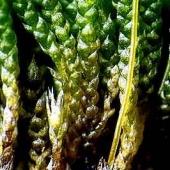Please select root levels for the menu
NZ Plants
Glyphothecium sciuroides
Family: Ptychomniaceae
-
1 glyphothecium_sciur855_plt2-800.jpg
Description: L Jensen
View picture -
3 glyphothecium_sciur855_br19-800.jpg
Description: L Jensen
View picture -
Leaf
Description: L Jensen
View picture -
Detached leaf
L Jensen
View picture -
Filamentous paraphyllia on stem between leaves
L Jensen
View picture -
Paraphyllia on stem with leaves removed
L Jensen
View picture -
Shoot with perigonia (scale-like leaves that enclose antheridia) in axils of leaves
L Jensen
View picture -
Opened perigonium with two sperm-containing antheridia exposed
L Jensen
View picture -
Fully opened perigonium with filamentous paraphyses and two antheridia
L Jensen
View picture -
Sporophyte plant with stalk (seta) and immature capsule
L Jensen
View picture -
Perichaetial bracts at base of seta
L Jensen
View picture -
Immature capsule with calyptra cover
L Jensen
View picture -
Splitting calyptra cover with operculum lid beneath
L Jensen
View picture -
Calyptra removed to expose the capsule operculum (lid)
L Jensen
View picture -
Mature capsule, operculum shed
L Jensen
View picture -
Peristome from above with green spores
L Jensen
View picture -
Peristome at an angle to reveal the high basal membrane of the inner peristome (endostome)
L Jensen
View picture
Glyphothecium sciuroides forms dense erect or loose pendent turfs. Shoots are 1-10 cm long, bright green or olive green above, yellow to golden below and sparingly branched. Stems are orange-brown and bear minute leaf-like outgrowths (paraphyllia). Leaves are overlapping, ovate-eliptic, 1.5-2.3 mm long, concave and with longitudinal folds (plicae) at the base and with long tapering tips and a finely-toothed margin. Dark filamentous brood bodies (gemmae) are borne on the upper parts of the stems. Capsules are erect, ovoid to cylindrical and deeply furrowed.
Widespread as an epiphyte in damp forest.

